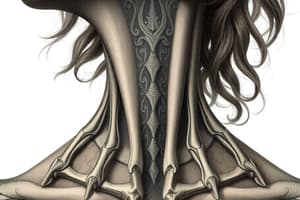Podcast
Questions and Answers
Which group of clavicular fractures involves fractures in the middle third of the bone?
Which group of clavicular fractures involves fractures in the middle third of the bone?
- Group IV
- Group II
- Group I (correct)
- Group III
What is the popular classification for lateral third fractures?
What is the popular classification for lateral third fractures?
- Type 3
- Type 1
- Type 2 (correct)
- Type 4
Which type of lateral third fracture involves a torn CC ligament with high riding of the fractured end of the clavicle?
Which type of lateral third fracture involves a torn CC ligament with high riding of the fractured end of the clavicle?
- Type 2 (correct)
- Type 3
- Type 4
- Type 1
What is the primary method of diagnosing clavicular fractures?
What is the primary method of diagnosing clavicular fractures?
What is the initial treatment for clavicular fractures in the majority of cases?
What is the initial treatment for clavicular fractures in the majority of cases?
At what time intervals should radiographs be obtained in adults to ensure fracture union?
At what time intervals should radiographs be obtained in adults to ensure fracture union?
Are complications common in clavicular fractures in children?
Are complications common in clavicular fractures in children?
What is the reason for swelling over the fracture in children after healing?
What is the reason for swelling over the fracture in children after healing?
How long should patients with clavicular fractures avoid heavy manual work?
How long should patients with clavicular fractures avoid heavy manual work?
Which type of clavicular fracture is more prone to non-union?
Which type of clavicular fracture is more prone to non-union?
In which type of clavicular fracture is internal fixation indicated for troublesome pain?
In which type of clavicular fracture is internal fixation indicated for troublesome pain?
What percentage of adult clavicular fractures result in non-union?
What percentage of adult clavicular fractures result in non-union?
Which patients usually require plating of the clavicle for clavicular fractures?
Which patients usually require plating of the clavicle for clavicular fractures?
What is the treatment for non-union of midshaft clavicular fractures?
What is the treatment for non-union of midshaft clavicular fractures?
What is the norm for delayed union or non-union in lateral third clavicular fractures?
What is the norm for delayed union or non-union in lateral third clavicular fractures?
When is non-operative treatment indicated for lateral third clavicular fractures?
When is non-operative treatment indicated for lateral third clavicular fractures?
What is the treatment for troublesome pain in lateral third clavicular fractures?
What is the treatment for troublesome pain in lateral third clavicular fractures?
Flashcards are hidden until you start studying
Study Notes
Clavicular Fractures Overview
- Middle third fractures of the clavicle are classified as group 2.
- Popular classification for lateral third fractures is the Neer classification.
Lateral Third Fractures
- Type II lateral third fractures involve a torn coracoclavicular (CC) ligament with high riding of the fractured end of the clavicle.
Diagnosis and Initial Treatment
- Primary method of diagnosing clavicular fractures is through physical examination and radiographic imaging.
- Initial treatment for the majority of clavicular fractures is conservative management, typically involving a sling or brace.
Radiographic Follow-Up
- Radiographs should be obtained at 2-week intervals in adults to ensure fracture union.
Complications and Healing in Children
- Complications in clavicular fractures are uncommon in children, making them generally less concerning than in adults.
- Swelling over the fracture site in children after healing is caused by overgrowth of callus tissue.
Recovery and Work Restrictions
- Patients with clavicular fractures should avoid heavy manual work for 6-12 weeks post-injury.
Non-Union Concerns
- Lateral third fractures are more prone to non-union compared to other types.
- Internal fixation is indicated for troublesome pain in type II or type III lateral third fractures.
Non-Union Statistics
- Approximately 15% of adult clavicular fractures result in non-union.
- Patients with multiple injury patterns or significant displacement usually require plating of the clavicle.
Treatment Strategies
- Non-union of midshaft clavicular fractures is typically treated with surgical intervention, such as internal fixation.
- Delayed union or non-union is less common in lateral third clavicular fractures due to their favorable healing conditions.
Non-Operative Treatment Indications
- Non-operative treatment for lateral third clavicular fractures is indicated if displacement is minimal.
- Conservative management includes rest and pain management for troublesome pain in lateral third fractures.
Studying That Suits You
Use AI to generate personalized quizzes and flashcards to suit your learning preferences.




